Targeting CD46 Enhances Anti-Tumoral Activity of Adenovirus Type 5 for Bladder Cancer
Abstract
1. Introduction
2. Results
2.1. CD46 Expression Is Inversely Correlated with Bladder Cancer Progression
2.2. CAR and CD46 Promote the Gene Transduction Efficacy of Ad5 and Ad5/35 Respectively Confirmed
2.3. CD46 Mediates Ad5/35 Gene Transduction in Bladder Cancer Cells
2.4. Efficacy of Ad5/35-Mediated Suicidal Gene Therapeutics Targeting CD46 in Human Bladder Cancer Cells In Vivo
3. Discussion
4. Materials and Methods
4.1. Immunohistochemistry
4.2. Cell Lines and Cell Culture
4.3. Viruses
4.4. Immunoblotting Analysis
4.5. FACScan Analysis and Immunofluorescence
4.6. Cell Killing Assay
4.7. Animal Studies
4.8. Statistical Analysis
5. Conclusions
Author Contributions
Funding
Acknowledgments
Conflicts of Interest
References
- Siegel, R.L.; Miller, K.D.; Jemal, A. Cancer statistics, 2018. CA Cancer J. Clin. 2018, 68, 7–30. [Google Scholar] [CrossRef] [PubMed]
- Anastasiadis, A.; de Reijke, T.M. Best practice in the treatment of nonmuscle invasive bladder cancer. Ther. Adv. Urol. 2012, 4, 13–32. [Google Scholar] [CrossRef] [PubMed]
- Zhai, Z.; Wang, Z.; Fu, S.; Lu, J.; Wang, F.; Li, R.; Zhang, H.; Li, S.; Hou, Z.; Wang, H.; et al. Antitumor effects of bladder cancer-specific adenovirus carrying e1a-androgen receptor in bladder cancer. Gene Ther. 2012, 19, 1065–1074. [Google Scholar] [CrossRef] [PubMed]
- Hall, M.C.; Chang, S.S.; Dalbagni, G.; Pruthi, R.S.; Seigne, J.D.; Skinner, E.C.; Wolf, J.S., Jr.; Schellhammer, P.F. Guideline for the management of nonmuscle invasive bladder cancer (stages ta, t1, and tis): 2007 update. J. Urol. 2007, 178, 2314–2330. [Google Scholar] [CrossRef] [PubMed]
- Bochner, B.H. Gene therapy in bladder cancer. Curr. Opin. Urol. 2008, 18, 519–523. [Google Scholar] [CrossRef] [PubMed]
- John, W.; Sons Ltd. Vectors Used in Gene Therapy Clinical Trials. Available online: http://www.abedia.com/wiley/vectors.php (accessed on 9 September 2018).
- Wold, W.S.; Toth, K. Adenovirus vectors for gene therapy, vaccination and cancer gene therapy. Curr. Gene Ther. 2013, 13, 421–433. [Google Scholar] [CrossRef] [PubMed]
- Hamilton, M.M.; Byrnes, G.A.; Gall, J.G.; Brough, D.E.; King, C.R.; Wei, L.L. Alternate serotype adenovector provides long-term therapeutic gene expression in the eye. Mol. Vis. 2008, 14, 2535–2546. [Google Scholar] [PubMed]
- Roelvink, P.W.; Lizonova, A.; Lee, J.G.; Li, Y.; Bergelson, J.M.; Finberg, R.W.; Brough, D.E.; Kovesdi, I.; Wickham, T.J. The coxsackievirus-adenovirus receptor protein can function as a cellular attachment protein for adenovirus serotypes from subgroups a,c,d,e, and f. J. Virol. 1998, 72, 7909–7915. [Google Scholar] [PubMed]
- Sirena, D.; Lilienfeld, B.; Eisenhut, M.; Kalin, S.; Boucke, K.; Beerli, R.R.; Vogt, L.; Ruedl, C.; Bachmann, M.F.; Greber, U.F.; et al. The human membrane cofactor cd46 is a receptor for species b adenovirus serotype 3. J. Virol. 2004, 78, 4454–4462. [Google Scholar] [CrossRef] [PubMed]
- Okegawa, T.; Sayne, J.R.; Nutahara, K.; Pong, R.C.; Saboorian, H.; Kabbani, W.; Higashihara, E.; Hsieh, J.T. A histone deacetylase inhibitor enhances adenoviral infection of renal cancer cells. J. Urol. 2007, 177, 1148–1156. [Google Scholar] [CrossRef] [PubMed]
- Ranki, T.; Hemminki, A. Serotype chimeric human adenoviruses for cancer gene therapy. Viruses 2010, 2, 2196–2212. [Google Scholar] [CrossRef] [PubMed]
- Hemminki, A.; Kanerva, A.; Liu, B.; Wang, M.; Alvarez, R.D.; Siegal, G.P.; Curiel, D.T. Modulation of coxsackie-adenovirus receptor expression for increased adenoviral transgene expression. Cancer Res. 2003, 63, 847–853. [Google Scholar] [PubMed]
- Arnberg, N. Adenovirus receptors: Implications for targeting of viral vectors. Trends Pharmacol. Sci. 2012, 33, 442–448. [Google Scholar] [CrossRef] [PubMed]
- Segerman, A.; Atkinson, J.P.; Marttila, M.; Dennerquist, V.; Wadell, G.; Arnberg, N. Adenovirus type 11 uses cd46 as a cellular receptor. J. Virol. 2003, 77, 9183–9191. [Google Scholar] [CrossRef] [PubMed]
- Gaggar, A.; Shayakhmetov, D.M.; Lieber, A. Cd46 is a cellular receptor for group b adenoviruses. Nat. Med. 2003, 9, 1408–1412. [Google Scholar] [CrossRef] [PubMed]
- Wang, H.; Li, Z.; Yumul, R.; Lara, S.; Hemminki, A.; Fender, P.; Lieber, A. Multimerization of adenovirus serotype 3 fiber knob domains is required for efficient binding of virus to desmoglein 2 and subsequent opening of epithelial junctions. J. Virol. 2011, 85, 6390–6402. [Google Scholar] [CrossRef] [PubMed]
- Wang, H.; Li, Z.Y.; Liu, Y.; Persson, J.; Beyer, I.; Moller, T.; Koyuncu, D.; Drescher, M.R.; Strauss, R.; Zhang, X.B.; et al. Desmoglein 2 is a receptor for adenovirus serotypes 3, 7, 11 and 14. Nat. Med. 2011, 17, 96–104. [Google Scholar] [CrossRef] [PubMed]
- Cho, Y.S.; Do, M.H.; Kwon, S.Y.; Moon, C.; Kim, K.; Lee, K.; Lee, S.J.; Hemmi, S.; Joo, Y.E.; Kim, M.S.; et al. Efficacy of cd46-targeting chimeric ad5/35 adenoviral gene therapy for colorectal cancers. Oncotarget 2016, 7, 38210–38223. [Google Scholar] [CrossRef] [PubMed]
- Liszewski, M.K.; Post, T.W.; Atkinson, J.P. Membrane cofactor protein (mcp or cd46): Newest member of the regulators of complement activation gene cluster. Annu. Rev. Immunol. 1991, 9, 431–455. [Google Scholar] [CrossRef] [PubMed]
- Cattaneo, R. Four viruses, two bacteria, and one receptor: Membrane cofactor protein (cd46) as pathogens’ magnet. J. Virol. 2004, 78, 4385–4388. [Google Scholar] [CrossRef] [PubMed]
- Galanis, E.; Atherton, P.J.; Maurer, M.J.; Knutson, K.L.; Dowdy, S.C.; Cliby, W.A.; Haluska, P., Jr.; Long, H.J.; Oberg, A.; Aderca, I.; et al. Oncolytic measles virus expressing the sodium iodide symporter to treat drug-resistant ovarian cancer. Cancer Res. 2015, 75, 22–30. [Google Scholar] [CrossRef] [PubMed]
- Kinugasa, N.; Higashi, T.; Nouso, K.; Nakatsukasa, H.; Kobayashi, Y.; Ishizaki, M.; Toshikuni, N.; Yoshida, K.; Uematsu, S.; Tsuji, T. Expression of membrane cofactor protein (mcp, cd46) in human liver diseases. Br. J. Cancer 1999, 80, 1820–1825. [Google Scholar] [CrossRef] [PubMed]
- Madjd, Z.; Durrant, L.G.; Pinder, S.E.; Ellis, I.O.; Ronan, J.; Lewis, S.; Rushmere, N.K.; Spendlove, I. Do poor-prognosis breast tumours express membrane cofactor proteins (cd46)? Cancer Immunol. Immunother. 2005, 54, 149–156. [Google Scholar] [CrossRef] [PubMed]
- Thorsteinsson, L.; O’Dowd, G.M.; Harrington, P.M.; Johnson, P.M. The complement regulatory proteins cd46 and cd59, but not cd55, are highly expressed by glandular epithelium of human breast and colorectal tumour tissues. APMIS 1998, 106, 869–878. [Google Scholar] [CrossRef] [PubMed]
- Weng, W.K.; Levy, R. Expression of complement inhibitors cd46, cd55, and cd59 on tumor cells does not predict clinical outcome after rituximab treatment in follicular non-hodgkin lymphoma. Blood 2001, 98, 1352–1357. [Google Scholar] [CrossRef] [PubMed]
- Yu, L.; Takenobu, H.; Shimozato, O.; Kawamura, K.; Nimura, Y.; Seki, N.; Uzawa, K.; Tanzawa, H.; Shimada, H.; Ochiai, T.; et al. Increased infectivity of adenovirus type 5 bearing type 11 or type 35 fibers to human esophageal and oral carcinoma cells. Oncol. Rep. 2005, 14, 831–835. [Google Scholar] [CrossRef] [PubMed]
- Yan, J.; Allendorf, D.J.; Li, B.; Yan, R.; Hansen, R.; Donev, R. The role of membrane complement regulatory proteins in cancer immunotherapy. Adv. Exp. Med. Biol. 2008, 632, 159–174. [Google Scholar] [PubMed]
- Vogels, R.; Zuijdgeest, D.; van Rijnsoever, R.; Hartkoorn, E.; Damen, I.; de Bethune, M.P.; Kostense, S.; Penders, G.; Helmus, N.; Koudstaal, W.; et al. Replication-deficient human adenovirus type 35 vectors for gene transfer and vaccination: Efficient human cell infection and bypass of preexisting adenovirus immunity. J. Virol. 2003, 77, 8263–8271. [Google Scholar] [CrossRef] [PubMed]
- Douglas, J.T.; Miller, C.R.; Kim, M.; Dmitriev, I.; Mikheeva, G.; Krasnykh, V.; Curiel, D.T. A system for the propagation of adenoviral vectors with genetically modified receptor specificities. Nat. Biotechnol. 1999, 17, 470–475. [Google Scholar] [CrossRef] [PubMed]
- Kawakami, Y.; Li, H.; Lam, J.T.; Krasnykh, V.; Curiel, D.T.; Blackwell, J.L. Substitution of the adenovirus serotype 5 knob with a serotype 3 knob enhances multiple steps in virus replication. Cancer Res. 2003, 63, 1262–1269. [Google Scholar] [PubMed]
- Sakurai, F.; Mizuguchi, H.; Yamaguchi, T.; Hayakawa, T. Characterization of in vitro and in vivo gene transfer properties of adenovirus serotype 35 vector. Mol. Ther. 2003, 8, 813–821. [Google Scholar] [CrossRef]
- Seshidhar Reddy, P.; Ganesh, S.; Limbach, M.P.; Brann, T.; Pinkstaff, A.; Kaloss, M.; Kaleko, M.; Connelly, S. Development of adenovirus serotype 35 as a gene transfer vector. Virology 2003, 311, 384–393. [Google Scholar] [CrossRef]
- Yamauchi, S.; Kawamura, K.; Okamoto, S.; Morinaga, T.; Jiang, Y.; Shingyoji, M.; Sekine, I.; Kubo, S.; Tada, Y.; Tatsumi, K.; et al. Replication-competent adenoviruses with the type 35-derived fiber-knob region achieve reactive oxygen species-dependent cytotoxicity and produce greater toxicity than those with the type 5-derived region in pancreatic carcinoma. Apoptosis 2015, 20, 1587–1598. [Google Scholar] [CrossRef] [PubMed]
- Parker, A.L.; White, K.M.; Lavery, C.A.; Custers, J.; Waddington, S.N.; Baker, A.H. Pseudotyping the adenovirus serotype 5 capsid with both the fibre and penton of serotype 35 enhances vascular smooth muscle cell transduction. Gene Ther. 2013, 20, 1158–1164. [Google Scholar] [CrossRef] [PubMed]
- Iguchi, K.; Sakurai, F.; Tomita, K.; Katayama, K.; Yamaguchi, T.; Kawabata, K.; Tagawa, M.; Kawabata, M.; Shirakawa, T.; Mizuguchi, H. Efficient antitumor effects of carrier cells loaded with a fiber-substituted conditionally replicating adenovirus on car-negative tumor cells. Cancer Gene Ther. 2012, 19, 118–125. [Google Scholar] [CrossRef] [PubMed]
- Potts, K.G.; Hitt, M.M.; Moore, R.B. Oncolytic viruses in the treatment of bladder cancer. Adv. Urol. 2012, 2012, 404581. [Google Scholar] [CrossRef] [PubMed]
- Liszewski, M.K.; Kemper, C.; Price, J.D.; Atkinson, J.P. Emerging roles and new functions of cd46. Springer Semin. Immunopathol. 2005, 27, 345–358. [Google Scholar] [CrossRef] [PubMed]
- Ly, P.T.; Tang, S.J.; Roca, X. Alternative polyadenylation expands the mrna isoform repertoire of human cd46. Gene 2017, 625, 21–30. [Google Scholar] [CrossRef] [PubMed]
- Bergelson, J.M.; Cunningham, J.A.; Droguett, G.; Kurt-Jones, E.A.; Krithivas, A.; Hong, J.S.; Horwitz, M.S.; Crowell, R.L.; Finberg, R.W. Isolation of a common receptor for coxsackie b viruses and adenoviruses 2 and 5. Science 1997, 275, 1320–1323. [Google Scholar] [CrossRef] [PubMed]
- Tomko, R.P.; Xu, R.; Philipson, L. Hcar and mcar: The human and mouse cellular receptors for subgroup c adenoviruses and group b coxsackieviruses. Proc. Natl. Acad. Sci. USA 1997, 94, 3352–3356. [Google Scholar] [CrossRef] [PubMed]
- Hemmi, S.; Geertsen, R.; Mezzacasa, A.; Peter, I.; Dummer, R. The presence of human coxsackievirus and adenovirus receptor is associated with efficient adenovirus-mediated transgene expression in human melanoma cell cultures. Hum. Gene Ther. 1998, 9, 2363–2373. [Google Scholar] [CrossRef] [PubMed]
- You, Z.; Fischer, D.C.; Tong, X.; Hasenburg, A.; Aguilar-Cordova, E.; Kieback, D.G. Coxsackievirus-adenovirus receptor expression in ovarian cancer cell lines is associated with increased adenovirus transduction efficiency and transgene expression. Cancer Gene Ther. 2001, 8, 168–175. [Google Scholar] [CrossRef] [PubMed]
- Kim, M.; Zinn, K.R.; Barnett, B.G.; Sumerel, L.A.; Krasnykh, V.; Curiel, D.T.; Douglas, J.T. The therapeutic efficacy of adenoviral vectors for cancer gene therapy is limited by a low level of primary adenovirus receptors on tumour cells. Eur. J. Cancer 2002, 38, 1917–1926. [Google Scholar] [CrossRef]
- Kim, J.S.; Lee, S.H.; Cho, Y.S.; Choi, J.J.; Kim, Y.H.; Lee, J.H. Enhancement of the adenoviral sensitivity of human ovarian cancer cells by transient expression of coxsackievirus and adenovirus receptor (car). Gynecol. Oncol. 2002, 85, 260–265. [Google Scholar] [CrossRef] [PubMed]
- Zhao, Y.; Li, Y.; Wang, Q.; Wang, L.; Yang, H.; Li, M. Increased antitumor capability of fiber-modified adenoviral vector armed with trail against bladder cancers. Mol. Cell. Biochem. 2011, 353, 93–99. [Google Scholar] [CrossRef] [PubMed]
- Gotoh, A.; Nagaya, H.; Kanno, T.; Tagawa, M.; Nishizaki, T. Fiber-substituted conditionally replicating adenovirus ad5f35 induces oncolysis of human bladder cancer cells in in vitro analysis. Urology 2013, 81, 920.e7–920.e11. [Google Scholar] [CrossRef] [PubMed]
- Maciejczyk, A.; Szelachowska, J.; Szynglarewicz, B.; Szulc, R.; Szulc, A.; Wysocka, T.; Jagoda, E.; Lage, H.; Surowiak, P. Cd46 expression is an unfavorable prognostic factor in breast cancer cases. Appl. Immunohistochem. Mol. Morphol. 2011, 19, 540–546. [Google Scholar] [CrossRef] [PubMed]
- Shang, Y.; Chai, N.; Gu, Y.; Ding, L.; Yang, Y.; Zhou, J.; Ren, G.; Hao, X.; Fan, D.; Wu, K.; et al. Systematic immunohistochemical analysis of the expression of cd46, cd55, and cd59 in colon cancer. Arch. Pathol. Lab. Med. 2014, 138, 910–919. [Google Scholar] [CrossRef] [PubMed]
- Studebaker, A.W.; Kreofsky, C.R.; Pierson, C.R.; Russell, S.J.; Galanis, E.; Raffel, C. Treatment of medulloblastoma with a modified measles virus. Neuro Oncol. 2010, 12, 1034–1042. [Google Scholar] [CrossRef] [PubMed]
- Wang, S.Y.; Weiner, G. Complement and cellular cytotoxicity in antibody therapy of cancer. Expert Opin. Biol. Ther. 2008, 8, 759–768. [Google Scholar] [CrossRef] [PubMed]
- Kesselring, R.; Thiel, A.; Pries, R.; Fichtner-Feigl, S.; Brunner, S.; Seidel, P.; Bruchhage, K.L.; Wollenberg, B. The complement receptors cd46, cd55 and cd59 are regulated by the tumour microenvironment of head and neck cancer to facilitate escape of complement attack. Eur. J. Cancer 2014, 50, 2152–2161. [Google Scholar] [CrossRef] [PubMed]
- Waehler, R.; Russell, S.J.; Curiel, D.T. Engineering targeted viral vectors for gene therapy. Nat. Rev. Genet. 2007, 8, 573–587. [Google Scholar] [CrossRef] [PubMed]
- Takagi-Kimura, M.; Yamano, T.; Tamamoto, A.; Okamura, N.; Okamura, H.; Hashimoto-Tamaoki, T.; Tagawa, M.; Kasahara, N.; Kubo, S. Enhanced antitumor efficacy of fiber-modified, midkine promoter-regulated oncolytic adenovirus in human malignant mesothelioma. Cancer Sci. 2013, 104, 1433–1439. [Google Scholar] [CrossRef] [PubMed]
- Strauss, R.; Sova, P.; Liu, Y.; Li, Z.Y.; Tuve, S.; Pritchard, D.; Brinkkoetter, P.; Moller, T.; Wildner, O.; Pesonen, S.; et al. Epithelial phenotype confers resistance of ovarian cancer cells to oncolytic adenoviruses. Cancer Res. 2009, 69, 5115–5125. [Google Scholar] [CrossRef] [PubMed]
- Ni, S.; Bernt, K.; Gaggar, A.; Li, Z.Y.; Kiem, H.P.; Lieber, A. Evaluation of biodistribution and safety of adenovirus vectors containing group b fibers after intravenous injection into baboons. Hum. Gene Ther. 2005, 16, 664–677. [Google Scholar] [CrossRef] [PubMed]
- Trinh, H.V.; Lesage, G.; Chennamparampil, V.; Vollenweider, B.; Burckhardt, C.J.; Schauer, S.; Havenga, M.; Greber, U.F.; Hemmi, S. Avidity binding of human adenovirus serotypes 3 and 7 to the membrane cofactor cd46 triggers infection. J. Virol. 2012, 86, 1623–1637. [Google Scholar] [CrossRef] [PubMed]
- Li, X.; Zhang, Y.P.; Kim, H.S.; Bae, K.H.; Stantz, K.M.; Lee, S.J.; Jung, C.; Jimenez, J.A.; Gardner, T.A.; Jeng, M.H.; et al. Gene therapy for prostate cancer by controlling adenovirus e1a and e4 gene expression with pses enhancer. Cancer Res. 2005, 65, 1941–1951. [Google Scholar] [CrossRef] [PubMed]
- Lee, S.J.; Kim, H.S.; Yu, R.; Lee, K.; Gardner, T.A.; Jung, C.; Jeng, M.H.; Yeung, F.; Cheng, L.; Kao, C. Novel prostate-specific promoter derived from psa and psma enhancers. Mol. Ther. 2002, 6, 415–421. [Google Scholar] [CrossRef] [PubMed]
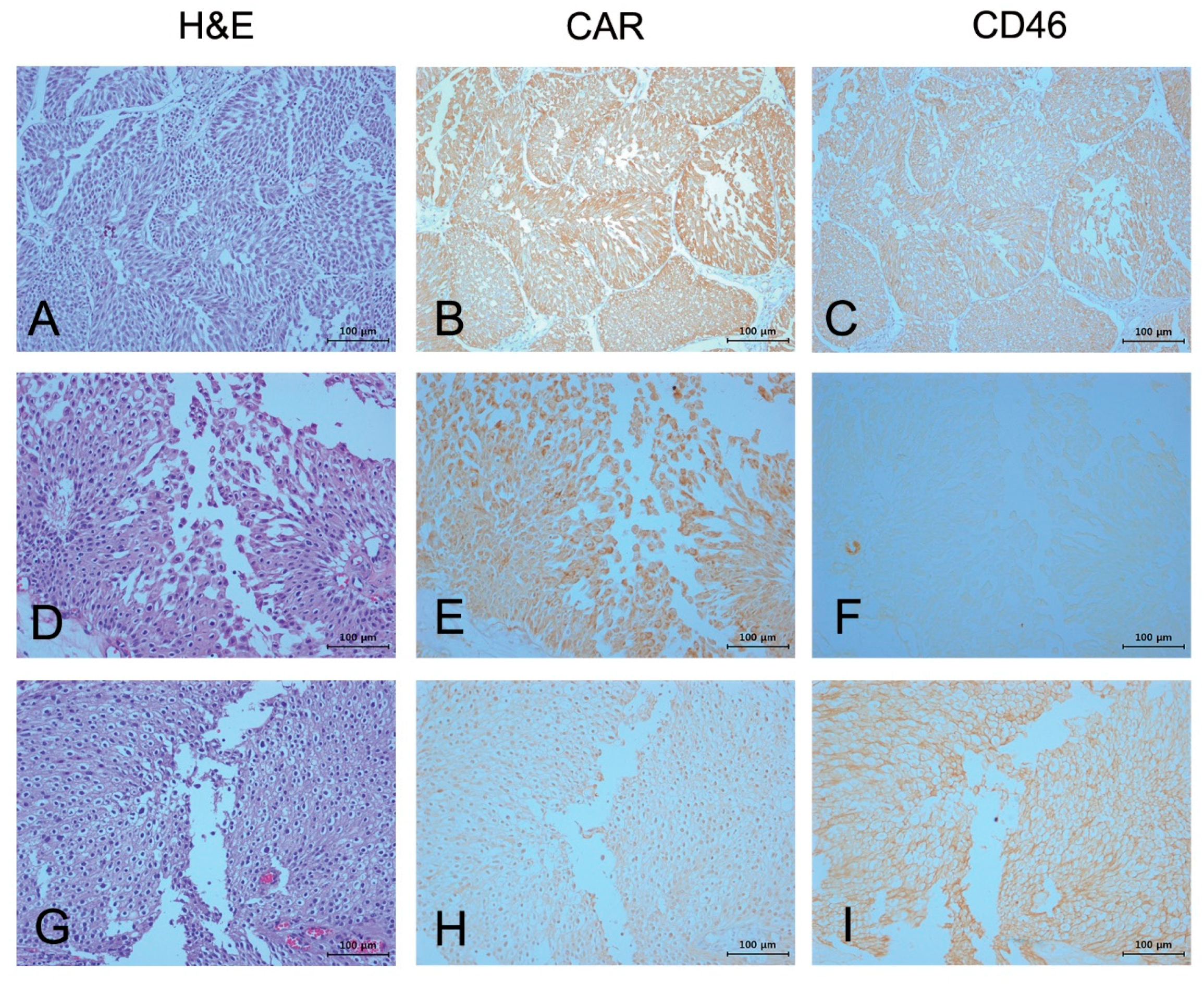
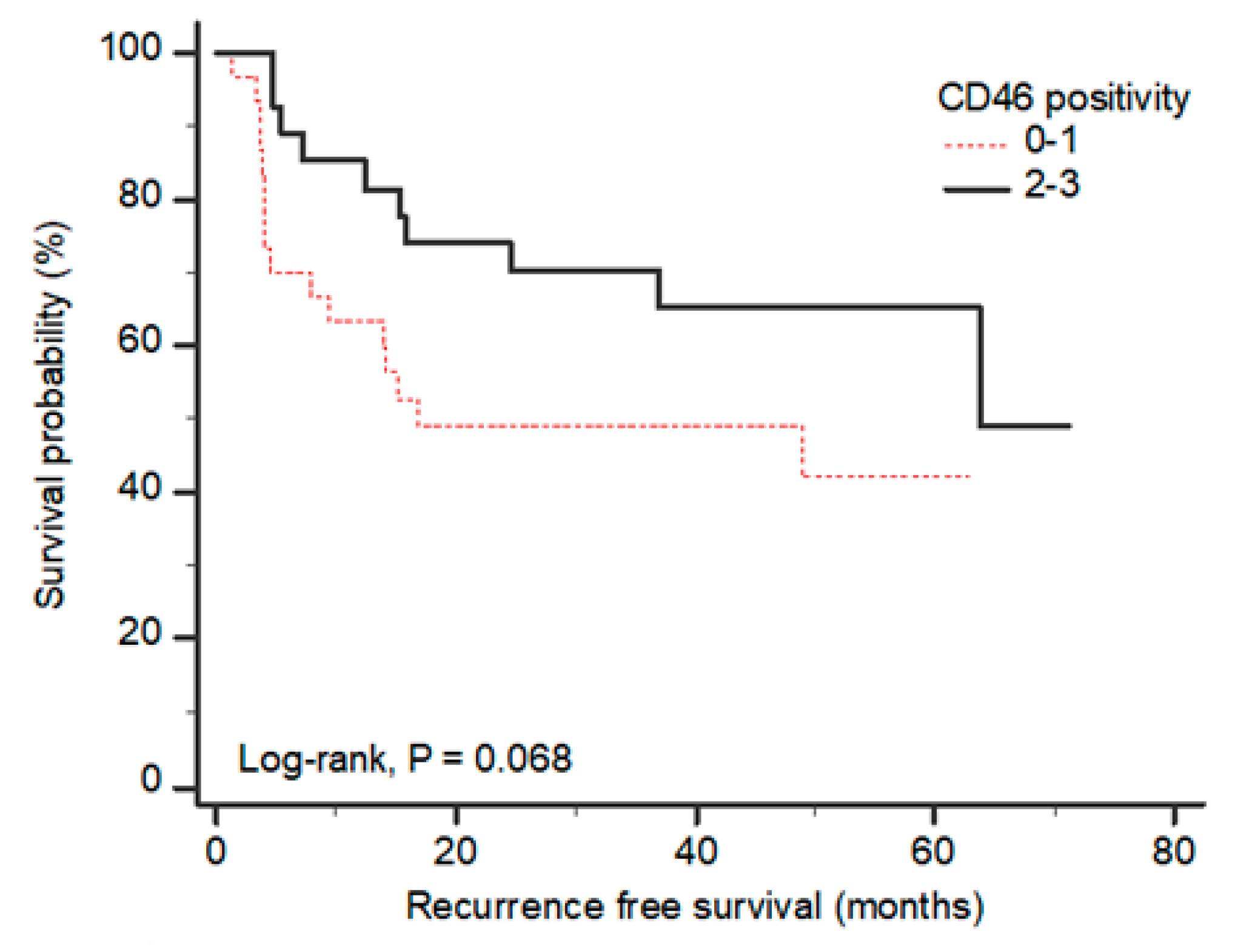
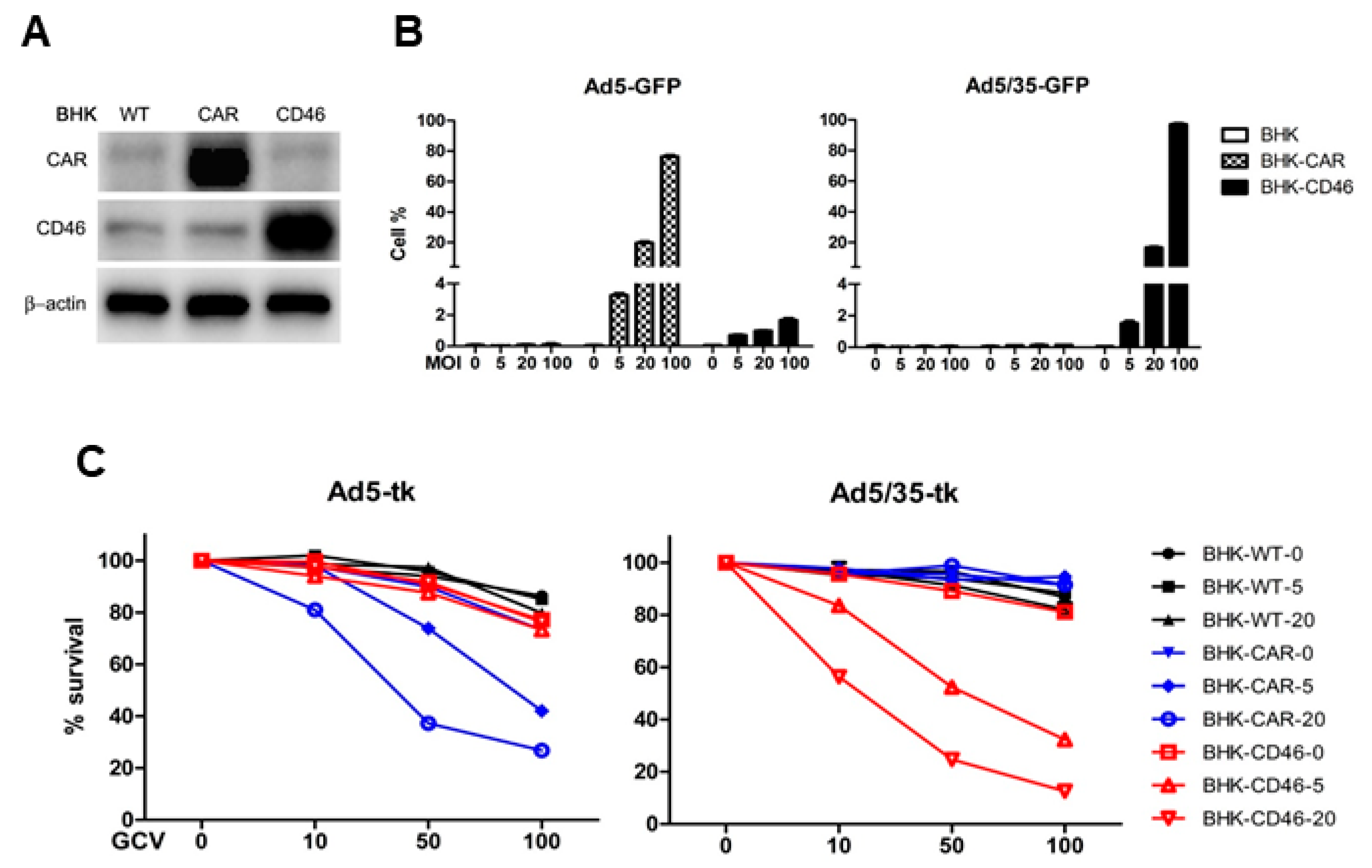
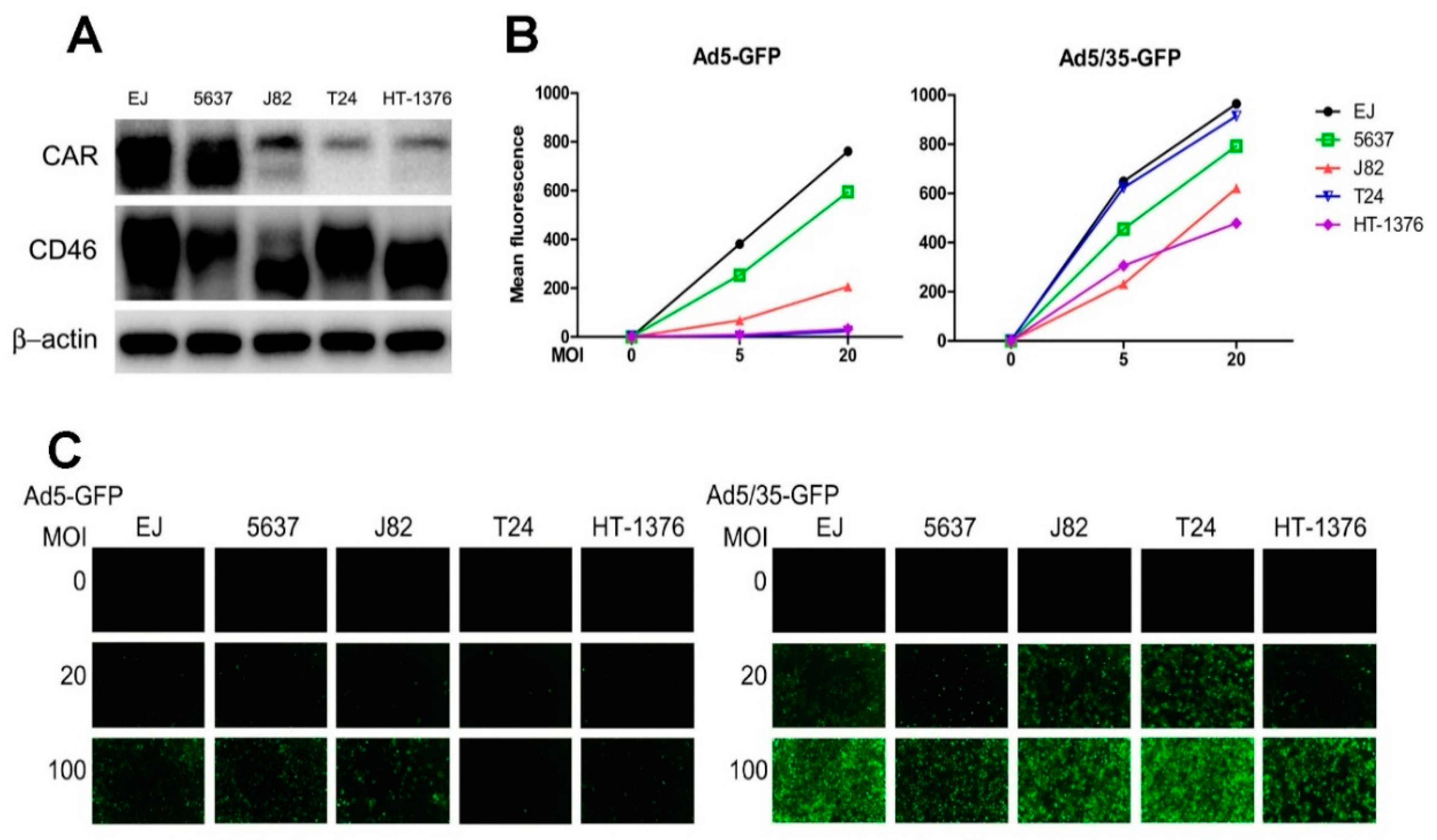
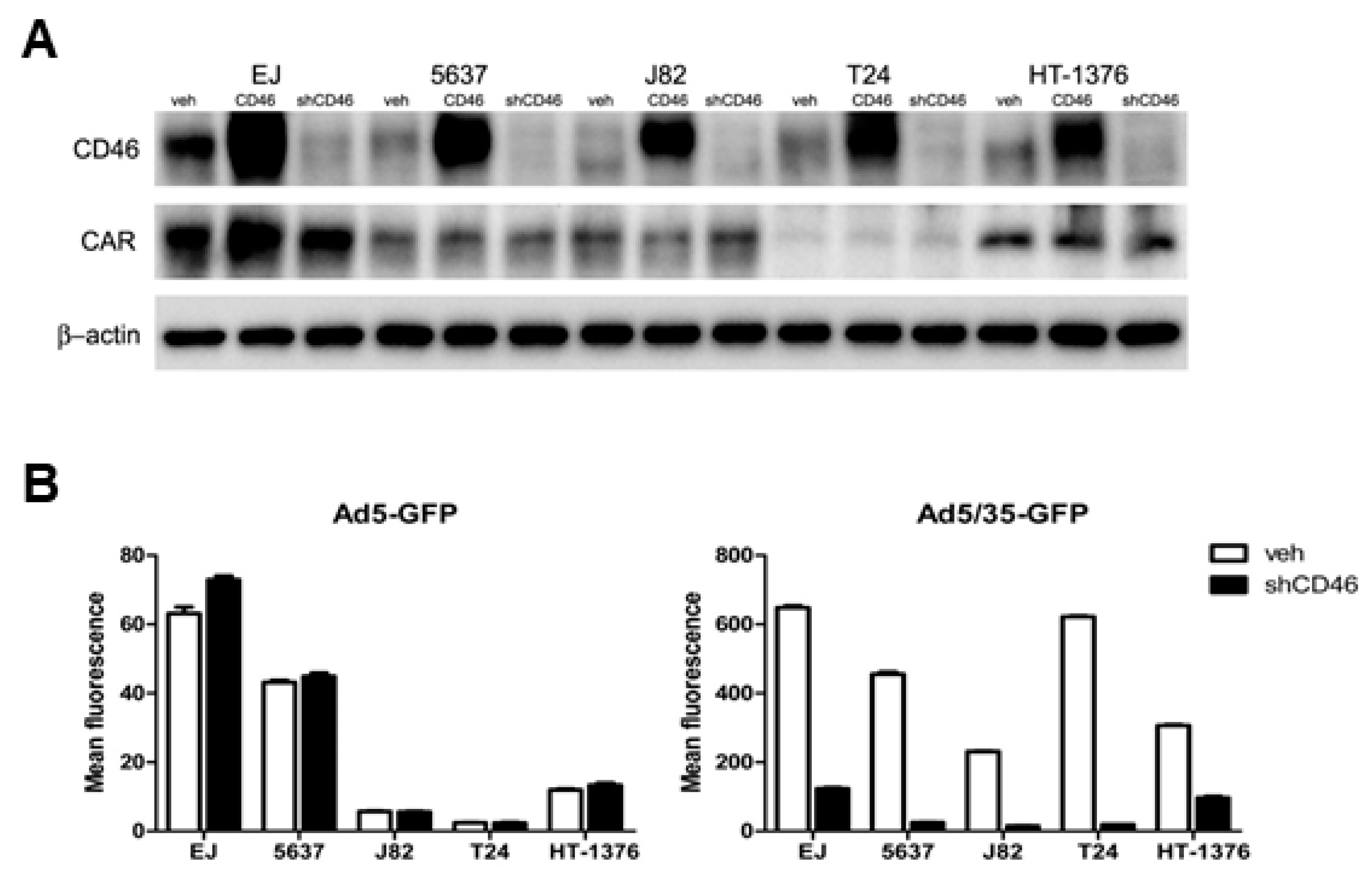
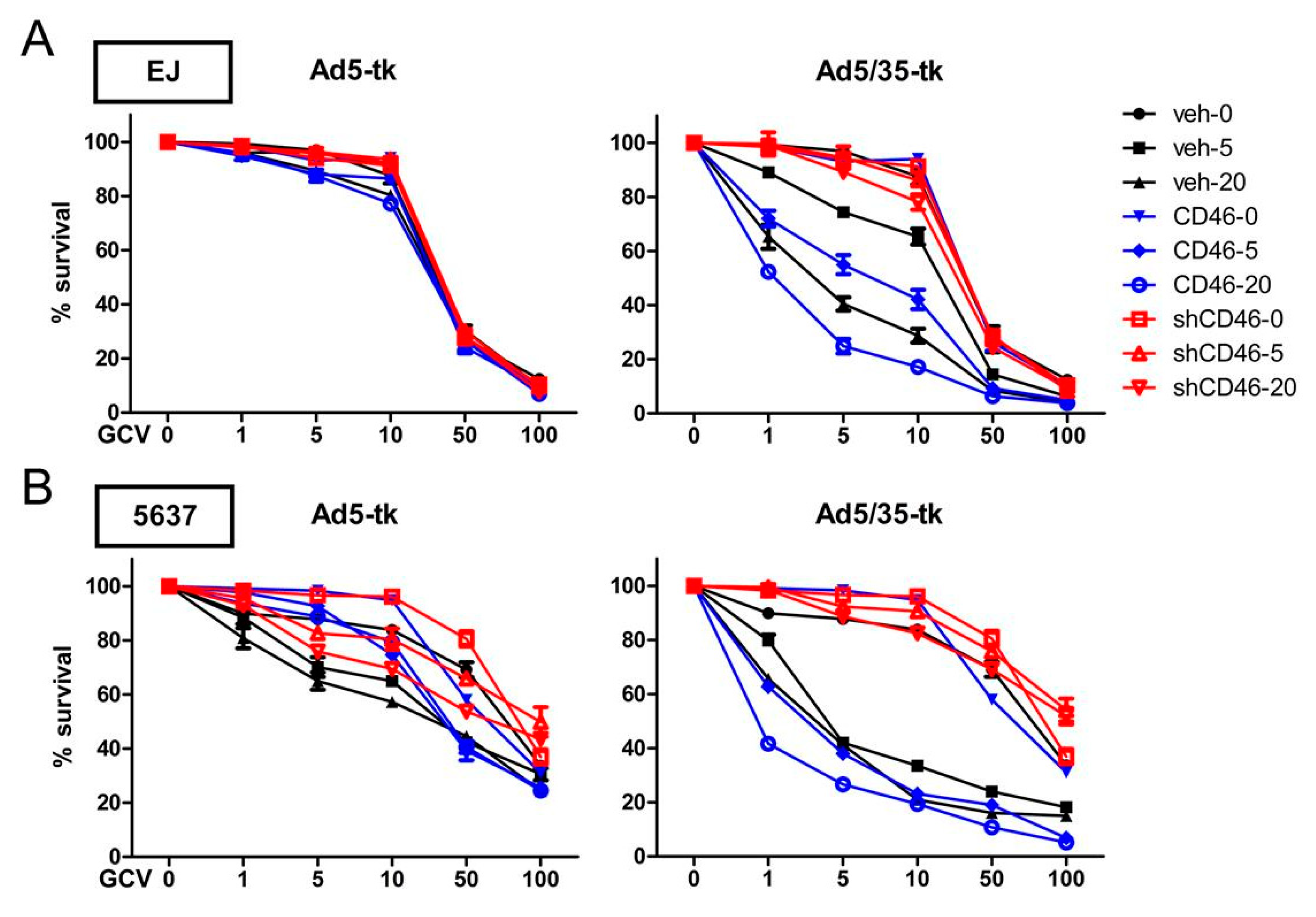
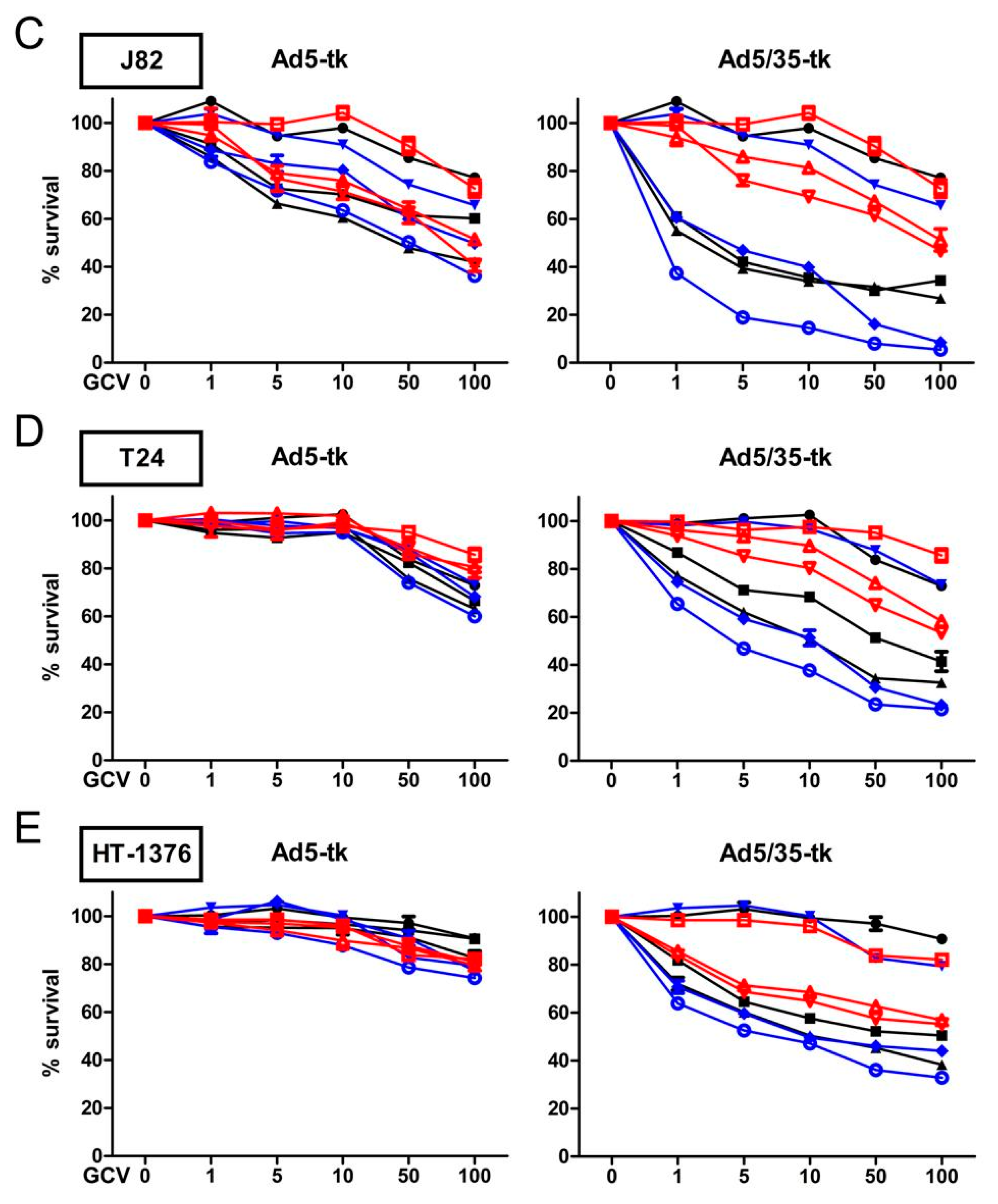

| Variables | All Patients (n = 59) | Low CD46 (n = 31) | High CD46 (n = 28) | p-Value * |
|---|---|---|---|---|
| Age (IQR) | 72.7 (63.4–78.3) | |||
| ≤73 | 30 (50.8) | 16 (51.6) | 14 (50.0) | 0.902 |
| >73 | 29 (49.2) | 15 (48.4) | 14 (50.0) | |
| Sex (n, %) | ||||
| Male | 46 (78.0) | 27 (87.1) | 19 (67.9) | 0.075 |
| Female | 13 (22.0) | 4 (12.9) | 9 (32.1) | |
| BMI (kg/m2, IQR) | 24.0 (22.0–26.1) | |||
| <25 | 37 (62.7) | 18 (58.1) | 19 (67.9) | 0.437 |
| ≥25 | 22 (37.3) | 13 (41.9) | 9 (32.1) | |
| ASA score | ||||
| 1 | 6 (10.2) | 2 (6.5) | 4 (14.3) | 0.503 |
| 2 | 47 (79.7) | 25 (80.6) | 22 (78.6) | |
| 3 | 6 (10.2) | 4 (12.9) | 2 (7.1) | |
| DM (n, %) | 12 (20.3) | 6 (19.4) | 6 (21.4) | 0.843 |
| Hypertension (n, %) | 32 (54.2) | 21 (67.7) | 11 (39.3) | 0.028 ** |
| Tumor size (cm, IQR) | 1.5 (1.0–3.0) | |||
| T stage (n, %) | ||||
| Ta | 34 (57.6) | 14 (45.2) | 20 (71.4) | 0.017 ** |
| T1 | 23 (39.0) | 17 (54.8) | 6 (21.4) | |
| CIS | 2 (3.4) | 0 (0) | 2 (7.1) | |
| Grade (n, %) | ||||
| Low | 32 (54.2) | 12 (38.7) | 20 (71.4) | 0.012 ** |
| High | 27 (45.8) | 19 (61.3) | 8 (28.6) | |
| Multifocality (n, %) | 21 (35.6) | 9 (29.0) | 12 (42.9) | 0.268 |
| Concomitant CIS (n, %) | 3 (5.1) | 1 (3.2) | 2 (7.1) | 0.494 |
| EORTC risk group (n, %) | ||||
| Low | 21 (35.6) | 8 (25.8) | 13 (46.4) | 0.042 ** |
| Intermediate | 11 (18.6) | 4 (12.9) | 7 (25.0) | |
| High | 27 (45.8) | 19 (61.3) | 8 (28.6) | |
| Intravesical Chemotherapy (n, %) | ||||
| No | 42 (71.2) | 22 (71.0) | 20 (71.4) | 0.129 |
| BCG | 14 (23.7) | 9 (29.0) | 5 (17.9) | |
| Adriamycin | 3 (5.1) | 0 (0) | 3 (10.7) | |
| Recurrence (n, %) | 26 (44.1) | 16 (51.6) | 10 (35.7) | 0.219 |
© 2018 by the authors. Licensee MDPI, Basel, Switzerland. This article is an open access article distributed under the terms and conditions of the Creative Commons Attribution (CC BY) license (http://creativecommons.org/licenses/by/4.0/).
Share and Cite
Do, M.-H.; To, P.K.; Cho, Y.-S.; Kwon, S.-Y.; Hwang, E.C.; Choi, C.; Cho, S.-H.; Lee, S.-J.; Hemmi, S.; Jung, C. Targeting CD46 Enhances Anti-Tumoral Activity of Adenovirus Type 5 for Bladder Cancer. Int. J. Mol. Sci. 2018, 19, 2694. https://doi.org/10.3390/ijms19092694
Do M-H, To PK, Cho Y-S, Kwon S-Y, Hwang EC, Choi C, Cho S-H, Lee S-J, Hemmi S, Jung C. Targeting CD46 Enhances Anti-Tumoral Activity of Adenovirus Type 5 for Bladder Cancer. International Journal of Molecular Sciences. 2018; 19(9):2694. https://doi.org/10.3390/ijms19092694
Chicago/Turabian StyleDo, Manh-Hung, Phuong Kim To, Young-Suk Cho, Se-Young Kwon, Eu Chang Hwang, Chan Choi, Sang-Hee Cho, Sang-Jin Lee, Silvio Hemmi, and Chaeyong Jung. 2018. "Targeting CD46 Enhances Anti-Tumoral Activity of Adenovirus Type 5 for Bladder Cancer" International Journal of Molecular Sciences 19, no. 9: 2694. https://doi.org/10.3390/ijms19092694
APA StyleDo, M.-H., To, P. K., Cho, Y.-S., Kwon, S.-Y., Hwang, E. C., Choi, C., Cho, S.-H., Lee, S.-J., Hemmi, S., & Jung, C. (2018). Targeting CD46 Enhances Anti-Tumoral Activity of Adenovirus Type 5 for Bladder Cancer. International Journal of Molecular Sciences, 19(9), 2694. https://doi.org/10.3390/ijms19092694




